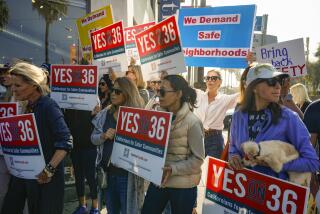Prop. 31: Good goals, problematic means
- Share via
SACRAMENTO — The most nerdy, wonky and nap-inducing measure on the Nov. 6 ballot is Proposition 31.
It’s not a minor measure, exactly, but it’s hardly monumental either.
It might do some good, might do some bad.
On the ballot, it’s called: “State Budget. State and Local Government. Initiative Constitutional Amendment and Statute.”
Are you still with me?
INTERACTIVE: 2012 California Propositions
It’s long and complex. To the average voter, I suspect, it reads like gobbledygook. I know it does to me.
The measure has two main goals:
•Make state government more efficient, transparent and prudent.
It tries to do this by tinkering with the legislative process and granting the governor more power to cut spending if the lawmakers won’t.
•Restore a smidgen of the local government control that flowed to Sacramento after property taxes were sharply cut 34 years ago by Proposition 13.
This is achieved by empowering and encouraging the locals to write their own rules for delivering state-funded services, including environmental protections. They’d get an additional $200 million from the state as an inducement.
The goals are worthy, the means questionable.
Prop. 31 is the product of California Forward, a blue-ribbon reform group generously funded by foundations. It has been trying for years, with limited success, to reform California government.
When the Legislature basically ignored its latest proposal, the organization went to the ballot with an initiative.
Half the $3 million-plus cost of collecting signatures was paid for by another would-be reformer, globe-trotting billionaire investor Nicolas Berggruen. But he seems to have abandoned the campaign after being screamed at by his environmentalist friends.
So let’s wade into this, preferably while injecting caffeine.
Among the measure’s features:
•State budgets would have to be enacted for two years, rather than just one. This would force some long-range planning.
Problem is, the governor and Legislature can’t even plan for two months, let alone two years. Budgets usually turn into red ink the moment they’re signed.
•A bill could not be passed unless it had been in print for three days. That’s to shine a light on back-room deals and eliminate end-of-session shenanigans.
“If a deal can’t stand up in sunshine, it’s probably not a good deal for the public,” says Jim Mayer, executive director of California Forward.
That’s a great concept in the abstract. I just don’t see it working in the practical world of effective legislating. A governor and Legislature should always be allowed to reach last-minute compromises.
•A funding source would have to be identified for a new spending program or tax cut that cost more than $25 million.
Another fine idea in concept, but not in the real world.
Democrats complain this amounts to a spending cap because any tax increase to fund a program would require a two-thirds legislative vote, a practical impossibility. And Republicans couldn’t cut a tax unless Democrats agreed to whack enough programs to pay for it.
Those ideological concerns aside, the funding source requirement is flawed because general obligation bonds and ballot initiatives would be exempt. So Prop. 31 would encourage more state borrowing and special interest initiatives, very bad ideas.
•A governor would have increased power to unilaterally cut spending in a fiscal emergency if the Legislature balked.
That one makes sense.
The most controversial element of Prop. 31 — one that sparked bitter debate on the California Forward council — is the shifting of some power from Sacramento to local governments.
Counties, cities and school districts could team up to deliver state-funded services their own way, discarding procedures laid out by Sacramento.
The Legislature could veto these local plans. But conservation activists and labor leaders fret that red counties — such as Orange and many mountain burgs — could discard state environmental and workplace protections.
“There’s no reason to allow local governments to worsen asthma conditions just because some developer is singing a swan song,” says Tom Adams, a longtime activist at the California League of Conservation Voters.
Nonsense, says Sunne McPeak, a former Contra Costa County supervisor and California Forward council member who strongly advocated the local government empowerment. “This is about local flexibility, not state regulations.”
Still, I wonder. I’d rather see just one statewide set of procedures, regulations or whatever you want to call them — not a different set in each county.
Moreover, it all seems like a full-employment act for lawyers.
“The state is tied up in knots already,” says Lenny Goldberg, executive director of the liberal California Tax Reform Assn. “This is just another layer of knots and constitutional restrictions.”
There’s also that extra $200 million the state would be handing local governments — money, Cal Forward says, to be saved from Gov. Jerry Brown’s shifting of prison burdens to the counties.
If it really exists, I’d like to see that $200 million spent on better law enforcement. Or on reducing university tuitions.
The Prop. 31 effort is OK, but prestigious reform groups such as California Forward should be setting their sights higher, tackling thorny problems that politicians don’t dare. Examples: Updating Prop. 13. Lowering the supermajority vote requirement for taxes. Really reforming education.
Voter confusion and ambivalence toward Prop. 31 are reflected in a recent survey of likely voters by the independent Field Poll. It found only 21% supporting the measure, with 40% opposed and an extraordinarily high 39% undecided.
Like most voters, when I’m not convinced, I vote no.
More to Read
Sign up for Essential California
The most important California stories and recommendations in your inbox every morning.
You may occasionally receive promotional content from the Los Angeles Times.














